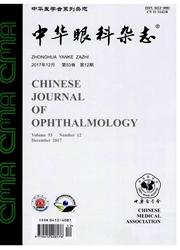

 中文摘要:
中文摘要:
目的探讨利用皮肤成纤维细胞替代角膜基质细胞,构建兔角膜基质组织的可行性。方法实验研究。通过酶消化的方法分离培养同种异体新生兔皮肤成纤维细胞,用腺病毒转染绿色荧光蛋白(GFP)基因标记细胞,接种细胞于聚羟基乙酸(PGA)圆盘支架,形成细胞.PGA复合物,移植于成年兔角膜基质层。动态观察构建组织在角膜内的变化情况,并于第3、6、8周取材进行大体、组织学、GFP表达及角膜基质特异蛋白Keratocan的检测。透射电镜观察胶原纤维排列并测量其直径。应用t检验统计分析数据。结果术后8周,实验侧角膜逐渐恢复透明,形成的新生角膜基质样组织,排列较规则。荧光显微镜检测显示GFP阳性细胞存在,形成基质板层样组织,同时该部分细胞表达Keratocan。胶原纤维排列规则,实验组胶原纤维直径为(33.08±2.47)nm,经统计学分析,与正常角膜差异无统计学意义(t=1.80,P=0.0771)。结论皮肤成纤维细胞可以替代角膜基质细胞,在兔角膜内构建组织工程角膜基质组织。
 英文摘要:
英文摘要:
Objective To explore whether skin fibroblasts could be used as a cell source for reconstruction of the corneal stroma. Methods It was an experimental study. Skin fibroblast cells were isolated from newborn rabbits, cultured and expanded in vitro. Cells were labeled with green fluorescence protein (GFP) gene by retro-viral infection. Fibroblasts at passage 3 were seeded on polyglicolic acid (PGA) non-woven fibers to form a cell-scaffold construct. Constructs were then implanted into the adult rabbit corneal stroma layer after being cultured in vitro for 1 week. Engineered stroma were observed continuously and harvested after 8 weeks of transplantation for gross, histological evaluation and Keratocan examination. PGA alone was used as control. Results The engineered tissue in the cornea became transparent gradually over a period of 8 weeks. Histological analysis showed that engineered stromal lamellar was relatively regular and the orientation of fibers was parallel to the surface of cornea, which is similar to normal cornea. The implanted cells were confirmed by GFP expression under fluorescent microscope, which also express Keratocan. By transmission electron microscopy examination, no significant difference in the diameter of collagen fiber was observed between engineered stroma ( 33.08 ± 2.47 )nm and normal stroma (t = 1.80, P = 0. 0771 ). Conclusion Skin fibroblast cells could be used as seed cells for reconstruction of the corneal stroma.
 同期刊论文项目
同期刊论文项目
 同项目期刊论文
同项目期刊论文
 期刊信息
期刊信息
